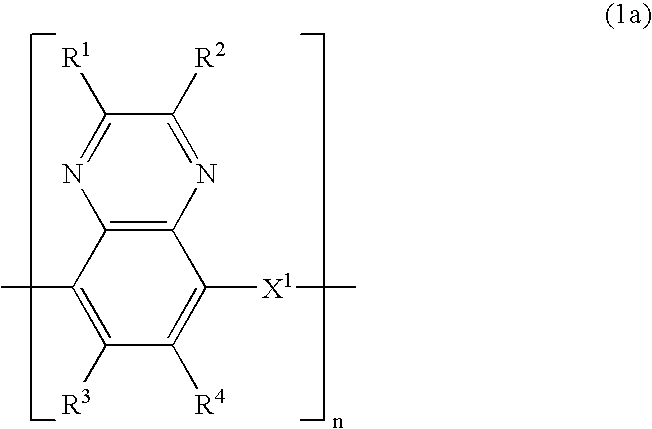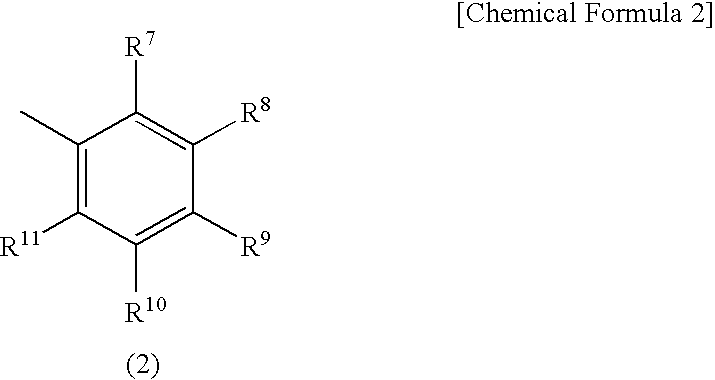Electrode for energy storage device and process for producing the same
- Summary
- Abstract
- Description
- Claims
- Application Information
AI Technical Summary
Benefits of technology
Problems solved by technology
Method used
Image
Examples
synthetic example 1
Synthesis of 2,3-dihydroxy-5-aminoquinoxaline
[0074] Prepared according to the following procedures (1) to (3).
(1) Synthesis of 2,3-diaminonitrobenzene
[0075] 14 g of commercially available 1-amino-2,5-dinitrobenzene was dissolved in 225 ml of methanol, to which a solution of 60 g of sodium sulfide and 21 g of sodium hydrogen carbonate dissolved in 240 g of water was added by use of a dropping funnel while keeping the reaction temperature at 60° C. After completion of the addition, agitation was continued at 60° C. for 1 hour. After completion of the reaction, the mixture was cooled down to room temperature and filtered.
[0076] m / z: (FD+) 153 (calculated 153.1396) 1H-NMR: 7.7228, 7.7203, 7.7206, 7.2433, 6.9245, 6.6209, 6.6063, 6.6038, 6.5886, 5.9210, 3.3978 ppm Yield: 7.79 g (66.5%) Product aspect: Reddish brown fine crystals Melting point: 140° C.
(2) Synthesis of 2,3-dihydroxy-5-nitroquinoxaline
[0077] 4 g (26.12 mmol) of 2,3-diaminonitrobenzene and 6.59 g (52.24 mmol) of com...
synthetic example 2
Synthesis of 2,3-diphenyl-5-aminoquinoxaline
[0081] Prepared according to the following procedures (1) and (2).
(1) Synthesis of 2,3-diphenyl-5-aminoquinoxaline
[0082] 1.53 g (10 mmol) of 2,3-diaminonitrobenzene and 2.00 g (9.6 mmol) of benzil were placed in four-necked flask, to which 30 g of a solvent of acetic acid and methanol at a mixing ratio of 1:1 was added for dissolution. Subsequently, the mixture was reacted at a reaction temperature of 70° C. for 2 hours. After the reaction, the solvent was removed and the resulting product was extracted with a silica gel column (ethyl acetate:hexane=1:1).
[0083] Yield: 2.11 g Product aspect: Yellow fine crystals m / z: 327 (calculated 327.24)
(2) Synthesis of 2,3-diphenyl-5-aminoquinoxaline
[0084] 1.04 g of 2,3-diphenyl-5-nitroquinoxaline was dissolved in 30 g of dioxane, followed by purging with argon and further addition of 0.5 g of 5% Pd / C (hydrous). After sufficient purging with argon again, hydrogen was added and reacted at room ...
synthetic example 3
Synthesis of 2,3-di(4-methylphenyl)-5-aminoquinoxaline
[0086] Prepared according to the following procedures (1) and (2).
(1) Synthesis of 2,3-di(4-methylphenyl)-5-nitroquinoxaline
[0087] 1.84 g (12 mmol) of 2,3-diaminonitrobenzene and 2.38 g (10 mmol) of 4,4′-dimethylbenzil were dissolved in 40 g of a mixed solvent of acetic acid and methanol (1:1) and reacted at a reaction temperature of 80° C. for 4 hours. After completion of the reaction, the solvent was removed and the resulting reaction product was extracted by means of a silica gel column.
[0088] Yield: 1.30 g Product aspect: Yellow fine crystals m / z: 355 (calculated 355.39) 13C-NMR: 154.8950, 154.8339, 147.0894, 140.7563, 140.1307, 139.8636, 135.5984, 135.1253, 133.7061, 133.2254, 130.2725, 129.7003, 129.3188, 129.1204, 128.4108, 127.7470, 124.2142 ppm
(2) Synthesis of 2,3-di(4-methylphenyl)-5-aminoquinoxaline
[0089] 2.02 g of 2,3-di(4-methylphenyl)-5-nitroquinoxaline was dissolved in 30 g of dioxane, followed by purging...
PUM
| Property | Measurement | Unit |
|---|---|---|
| Time | aaaaa | aaaaa |
| Time | aaaaa | aaaaa |
| Weight | aaaaa | aaaaa |
Abstract
Description
Claims
Application Information
 Login to View More
Login to View More - Generate Ideas
- Intellectual Property
- Life Sciences
- Materials
- Tech Scout
- Unparalleled Data Quality
- Higher Quality Content
- 60% Fewer Hallucinations
Browse by: Latest US Patents, China's latest patents, Technical Efficacy Thesaurus, Application Domain, Technology Topic, Popular Technical Reports.
© 2025 PatSnap. All rights reserved.Legal|Privacy policy|Modern Slavery Act Transparency Statement|Sitemap|About US| Contact US: help@patsnap.com



